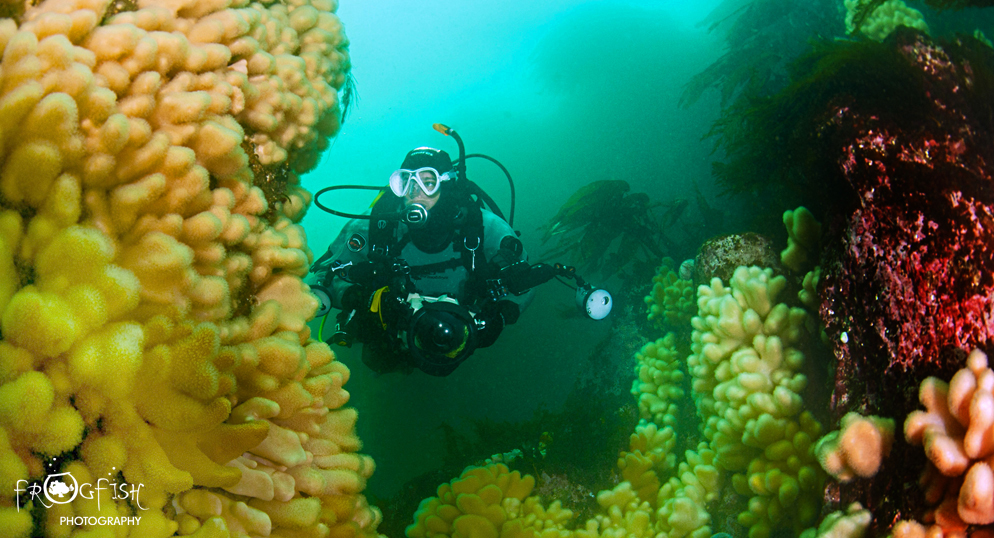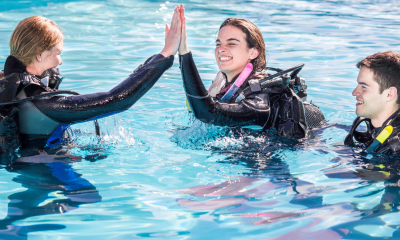Marine Life & Conservation
Consultation on bottom trawling in Marine Protected Areas welcomed by Marine Conservation Society

 A consultation launched by the UK’s Marine Management Organisation has been welcomed by the Marine Conservation Society.
A consultation launched by the UK’s Marine Management Organisation has been welcomed by the Marine Conservation Society.
The MMO has launched the consultation to explore whether bottom towed fishing activity should be prohibited in four Marine Protected Areas where there is evidence they harm wildlife or damage habitats.
Earlier this year the Marine Conservation Society released its Marine unProtected Areas report which found that bottom towed fishing gear was being used in almost all of the UK’s protected areas designated specifically to safeguard the seabed. As a result, the charity called for a ban on bottom trawling in these areas intended to protect the seabed. The consultation is a positive step in the right direction.
The charity’s report found that bottom trawl and dredge vessels spent at least 89,894 hours fishing the seabed inside Marine Protected Areas between 2015 and 2018.
Banning the bottom trawling of these protected seabeds would not only be positive for restoration efforts, but would be climate smart. Not only does bottom trawling damage vital underwater habitats but it also churns up the seafloor, releasing carbon into the ocean and, potentially, the atmosphere. It’s estimated that carbon emissions released by bottom trawling across the UK continental shelf between 2016 and 2040 could cost up to £9 billion to mitigate in other areas of the economy.
One of the four sites being considered is Dogger Bank, off the east of England, which is 12,300 km square of seabed – half the size of Wales. The Dogger Bank Marine Protected Area has the capacity to store the most carbon of all UK Marine Protected Areas– equivalent to 31,000 return flights from London to Sydney. Banning bottom trawling in this area alone would have a huge impact on wildlife recovery and the limiting of carbon emissions.
Dr Jean-Luc Solandt, Principle Specialist in Marine Protected Areas at the Marine Conservation Society said: “You’d think that Marine Protected Areas are, in fact, protected. However, just 5% currently ban bottom trawling, which has been shown time and again to damage the fragile sea floor. Whilst in the past the UK have had to get full agreement from other EU member states for bans on fishing, now we can act independently with the powers provided by the Fisheries Act.
“This announcement – whilst only for 4 of a possible 74 areas of protection – is an encouraging start. After years of heavily degrading our seas are we finally starting to see measures that can provide the green shoots of recovery?”
Within five years of protection from bottom trawling, animals in three UK and Isle of Man Marine Protected Areas were found to be larger and more diverse. When areas of sea around the world were fully protected, biodiversity was found to increase by an average of 21%. Alongside flora and fauna bouncing back, carbon stores are left undisturbed and are able to build back up, as new life emerges on the seabed.
For more information about the work of the Marine Conservation Society visit their website by clicking here.
Blogs
Invitation from The Ocean Cleanup for San Francisco port call

6 years ago, The Ocean Cleanup set sail for the Great Pacific Garbage Patch with one goal: to develop the technology to be able to relegate the patch to the history books. On 6 September 2024, The Ocean Cleanup fleet returns to San Francisco bringing with it System 03 to announce the next phase of the cleanup of the Great Pacific Garbage Patch and to offer you a chance to view our cleanup system up-close and personal.
We look forward to seeing you there.
To confirm your presence, please RSVP to press@theoceancleanup.com
PROGRAM
Join The Ocean Cleanup as our two iconic ships and the extraction System 03 return to San Francisco, 6 years and over 100 extractions after we set sail, to create and validate the technology needed to rid the oceans of plastic.
Our founder and CEO, Boyan Slat, will announce the next steps for the cleanup of the Great Pacific Garbage Patch. Giving you a chance to view our cleanup system and the plastic extracted.
Hear important news on what’s next in the mission of The Ocean Cleanup as it seeks to make its mission of ridding the world’s oceans of plastic an achievable and realistic goal.
Interviews and vessel tours are available on request.
PRACTICALITIES
Date: September 6, 2024
Press conference: 12 pm (noon)
Location: The Exploratorium (Google Maps)
Pier 15 (Embarcadero at Green Street), San Francisco, CA
Parking: Visit The Exploratorium’s website for details.
RSVP: press@theoceancleanup.com
Video & photo material from several viewing spots around the bay
We look forward to seeing you there!
ABOUT THE OCEAN CLEANUP
The Ocean Cleanup is an international non-profit that develops and scales technologies to rid the world’s oceans of plastic. They aim to achieve this goal through a dual strategy: intercepting in rivers to stop the flow and cleaning up what has already accumulated in the ocean. For the latter, The Ocean Cleanup develops and deploys large-scale systems to efficiently concentrate the plastic for periodic removal. This plastic is tracked and traced to certify claims of origin when recycling it into new products. To curb the tide via rivers, The Ocean Cleanup has developed Interceptor™ Solutions to halt and extract riverine plastic before it reaches the ocean. As of June 2024, the non-profit has collected over 12 million kilograms (26.4 million pounds) of plastic from aquatic ecosystems around the world. Founded in 2013 by Boyan Slat, The Ocean Cleanup now employs a broadly multi-disciplined team of approximately 140. The foundation is headquartered in Rotterdam, the Netherlands, and opened its first regional office in Kuala Lumpur, Malaysia, in 2023.
Find out more about The Ocean Cleanup at www.theoceancleanup.com.
Marine Life & Conservation
SHARK MONTH ARRIVES AT ROYAL WILLIAM YARD, PLYMOUTH

A shark has been spotted approaching Royal William Yard in Plymouth, much to the surprise of swimmers, paddleboarders and onlookers.
With its distinctive dorsal fin cutting through the water, the sizeable shark swam along the coastline, before turning to head inland towards Firestone Arch at Royal William Yard. The appearance drew a crowd, who were captivated for more than an hour by the unusual sight – and it was all caught on video.
The shark is one of many expected sightings at Royal William Yard over the coming weeks… because today marks the start of Shark Month!
In reality, the ‘shark’ spotted along the Plymouth shoreline was actually a custom-made model, created by the team at Royal William Yard and sailed underwater by Caroline Robertson‑Brown from the Shark Trust, who donned scuba diving gear for the occasion.
The stunt took place to launch Shark Month in style and draw attention to the work of the leading international conservation charity, which is based in Britain’s Ocean City. Spectators were reassured that the water was safe and many entered into the spirit of the performance, swimming or sailing alongside the shark.
Shark Month will take place across Royal William Yard throughout July and will feature an extravaganza of art, entertainment and advocacy for everyone to enjoy. The packed programme of events starts with an art exhibition and ends with a trip on paddleboards with shark experts – with everything from a shark quiz to a Jaws screening in between.
Paul Cox, CEO of the Shark Trust, said: “There are often assumptions and misconceptions when it comes to sharks. This was certainly the case with the shark spotted at Royal William Yard! While the British coastline is home to many species of shark, this was not one of them. However, we’re thrilled it caught people’s attention, because seeing a shark is a special and memorable moment. That is precisely why we want to celebrate these incredible creatures, highlight the need for conservation, and ask for help to safeguard their future.”
For more information about Shark Month at Royal William Yard, visit the Shark Trust Website.
Images and video: Jay Stone
-

 Blogs2 months ago
Blogs2 months agoDiving With… Nico, Ocean Earth Travels, Indonesia
-

 News1 month ago
News1 month agoMurex Bangka Announce New Oceanfront Cottages & Beachfront Dining
-

 Blogs2 months ago
Blogs2 months agoA new idea in freediving from RAID
-

 Marine Life & Conservation1 month ago
Marine Life & Conservation1 month agoIceland issue millionaire whale hunter a licence to murder 128 vulnerable fin whales
-

 Marine Life & Conservation2 months ago
Marine Life & Conservation2 months agoThe Shark Trust Great Shark Snapshot is back
-

 News3 months ago
News3 months agoCharting New Waters; NovoScuba Goes Global with the Launch of their Revolutionary Dive Training Agency!
-

 Gear News1 month ago
Gear News1 month agoNew Suunto Ocean – a dive computer and GPS sports watch in one for adventures below and above the surface
-

 Marine Life & Conservation Blogs2 months ago
Marine Life & Conservation Blogs2 months agoBook Review: Plankton














